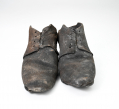site search
online catalog
INDIAN WAR ARMY SHOES BY MUNDELL FROM FORT PEMBINA, ND

$795.00
Quantity Available: 1
Item Code: 1052-387
Shipping: Determined by Method & Location of buyer
To Order:
Call 717-334-0347,
Fax 717-334-5016, or E-mail
This pair of shoes is from the excavations at Fort Pembina, ND, and could be taken for attic or barn-finds, having been preserved by the wet, anaerobic soil conditions of the dig. They are solid, can be handled, and display very well, showing as a dusty brown with some white stains. The right quarter of the left shoe is clearly stamped inside “MUNDELL,” a well-known Philadelphia shoe manufacturer with Civil War and postwar army contracts. These have some Civil War characteristics in using rough-side out black leather, now oxidized to brown, pegged soles, four simple lace holes on each side of the quarters, and a counter sewn in the heel. The slightly rounded toes, however, contoured sole, and higher heels, point to a slightly later date and suggest these might be private purchase for wear in the barracks and off duty in garrison, where they might still pass casual inspection, but be more comfortable. The latter seems to have been a particular priority here since the soldier modified them by cutting away the heel above the counter on both shoes, the cut curving up to the middle point at the ankle, leaving the fronts and lace holes intact and the alteration invisible from the front. See McChristian’s volumes on uniforms and gear of the frontier army in the 1870s and 1880-1892 for details and how the army responded or, in the early years, did not respond to the essential issues of comfort and durability in footwear. Reports of the early frontier army are filled with notes on the wide variety of footgear worn both on campaign and in garrison.
These display very well, are solid and can be handled. The left shoe shows wear on the sole at the toe and a slight separation of seam joining the vamp and quarters on the left. The right shoe shows more damage to the sole at front right and larger gap between vamp and quarters on the left, though also with no leather missing, but all the parts are stiff, tight, and not falling apart.
Fort Pembina was situated in the Red River Valley in North Dakota near the Canadian border, established in 1870 and in operation until 1895. Trading posts existed earlier in the area as part of the fur trade, and the first U.S. military post there was temporary- manned by a detachment of Minnesota troops in 1863-1864 following the 1862 Sioux uprising. In March 1870 a new fort was established south of the Pembina River and about 200 yards west of the Red River, completed by July and named in honor of Gen. George H. Thomas. The name was changed to Fort Pembina in September and the initial garrison consisted of two companies of the 20th US Infantry and excavations show that, as is typical of the early Indian Wars regular army, their uniforms and gear were a mix of Civil War surplus issue, private purchase material, and later army issue patterns and private purchases as time went on. Their main duty was to provide security for settlers worried about Sioux returning south from Canada, but the troops were more occupied with escorting boundary surveys along the Canadian border and preventing Fenian raids heading north into Canada.
The fort included enlistedmen’s barracks, officers’ quarters, guard house, ordnance storehouse, company kitchen, root house, laundress’s quarters, quarters for civilian employees, hospital and hospital servant’s house, a barn for the “hospital cow,” quartermaster and commissary offices and storehouse, stables, wagon shed, etc. The garrison reached peak strength in 1878 af 200, but the average was about 125 enlisted men and 8 officers. An October 1885 return listed 97 men, 2 field pieces, 1 mountain howitzer, 100 rifles, 19 pistols, 23 mules, and 9 wagons. By 1890 the post had just 23 men, and after an 1895 fire destroyed some 19 buildings it was decided to abandon the fort rather than rebuild, the last detachment left in September. The property was turned over to the Interior Department and later sold in 1902.
This is an interesting pair of shoes with a tight provenance to a small, postwar, US army frontier post and would be a nice part of a collection or display related to the western forts and garrison life in the Indian Wars. [sr] [ph:m]
~~~~~~~~~~~~~~~~~~~~~~~~~~~~~~~~~~~
THIS ITEM, AS WITH ALL OTHER ITEMS AVAILABLE ON OUR WEB SITE,
MAY BE PURCHASED THROUGH OUR LAYAWAY PROGRAM.
CLICK HERE FOR OUR POLICIES AND TERMS.
THANK YOU!
Inquire About INDIAN WAR ARMY SHOES BY MUNDELL FROM FORT PEMBINA, ND
For inquiries, please email us at [email protected]
Most Popular
Historical Firearms Stolen From The National Civil War Museum In Harrisburg, Pa »
Theft From Gravesite Of Gen. John Reynolds »
Selection Of Unframed Prints By Don Troiani »
Fine Condition Brass Infantry Bugle Insignia »
British Imported, Confederate Used Bayonet »
Scarce New Model 1865 Sharps Still In Percussion Near Factory New »
featured item
RARE IDENTIFIED 65th NY SERGEANT’S JACKET, WITH MANSCRIPT MATERIAL: 1st U.S. CHASSEURS
This is an extremely rare, early-war uniform jacket, with related material, belonging to a sergeant of the 65th New York, who enlisted at the beginning of the war as the regiment’s commissary sergeant, and gained a lieutenant’s commission in a… (1179-233). Learn More »
site search
Upcoming Events
May 16 - 18: N-SSA Spring Nationals, Fort Shenandoah, Winchester, VA Learn More »











